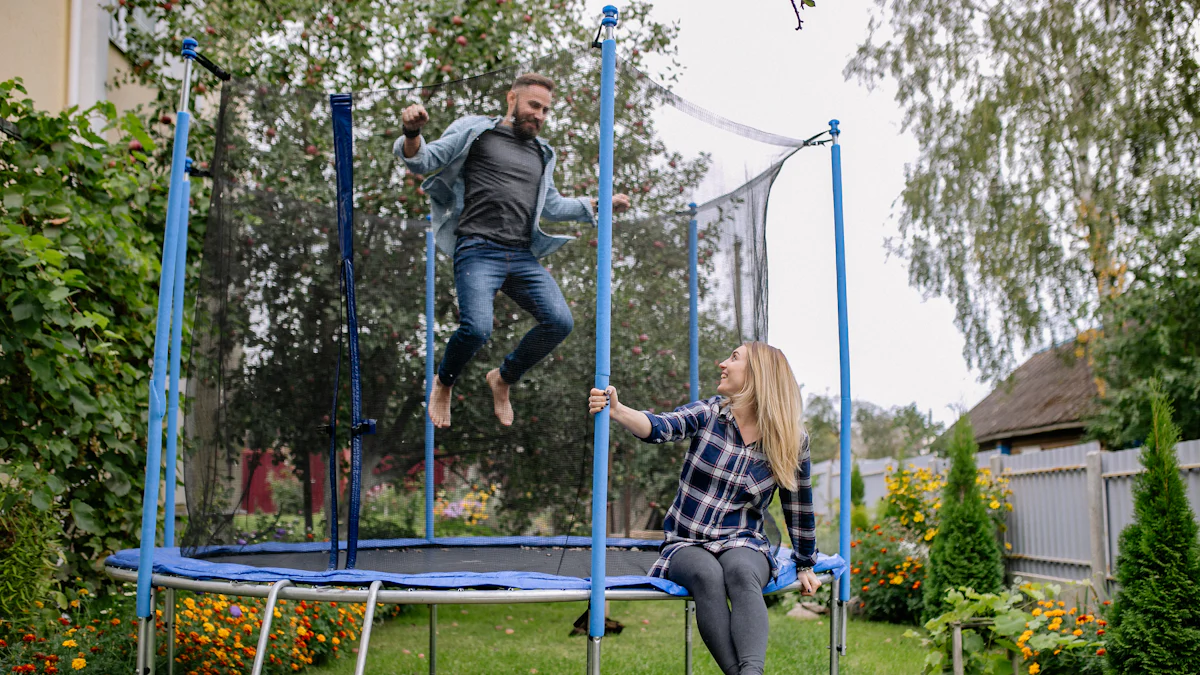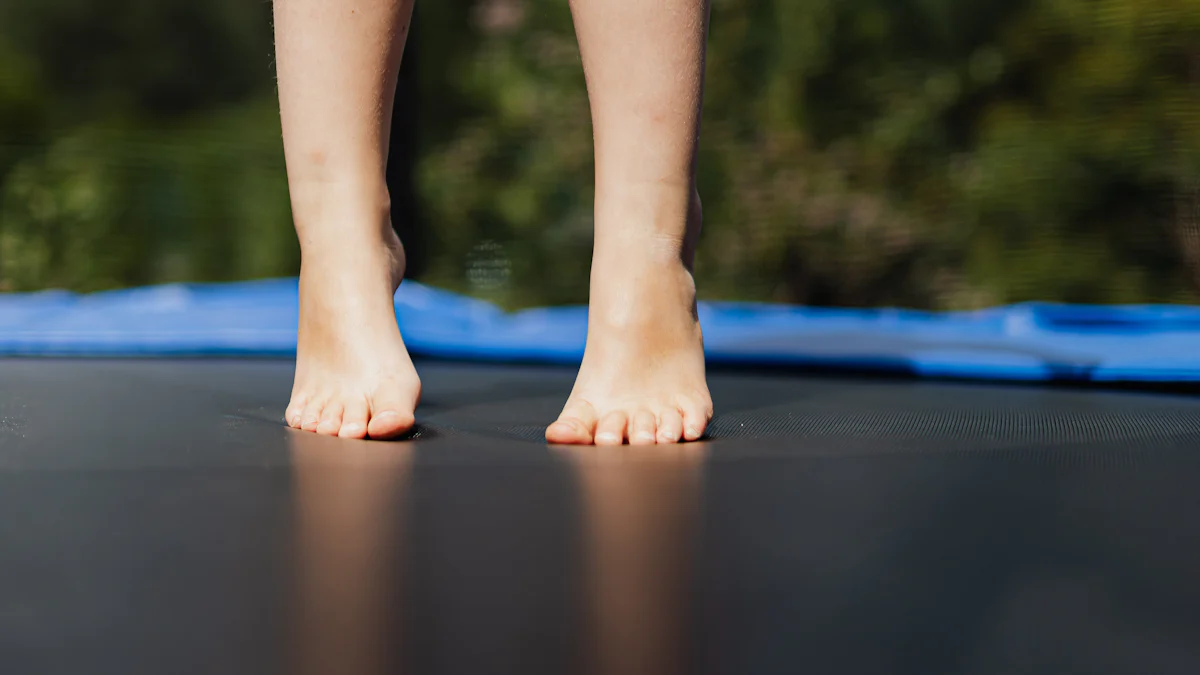
Setting up a children’s trampoline might seem simple, but safety should always come first. Did you know over 800,000 kids in the U.S. suffered trampoline-related injuries between 2009 and 2018? Most of these happened at home. Proper setup can prevent falls, collisions, and other risks. With the right precautions, trampolining becomes a fun way for kids to stay active, improve balance, and even make new friends.
Key Takeaways
- Choose a flat, open area for the trampoline. Keep at least 9 feet of clear space around it to prevent accidents.
- Gather the right tools before starting assembly. Use a spring puller and gloves to make the process easier and safer.
- Always install a safety net. It prevents falls and keeps kids safe while jumping.
Preparing for Setup
Choosing the Right Location for a Children’s Trampoline
Picking the perfect spot for your children’s trampoline is the first step to ensuring safety and fun. I always recommend looking for a flat, open area with plenty of space around it. You don’t want the trampoline too close to walls, fences, or trees. Why? Because kids can accidentally bump into these while jumping.
Here’s a quick guide to help you decide:
| Factor | Description |
|---|---|
| Size and Height of Area | Make sure the space is large enough and free from low-hanging branches or wires. |
| Safety Perimeter | Leave at least 9 feet of clear space around the trampoline. |
| Surface | Choose a level surface like grass or a soft mat to reduce the risk of tipping over. |
| Nearby Hazards | Avoid areas near pools, driveways, or hard surfaces like concrete. |
A good location ensures your kids can jump freely without worrying about obstacles or accidents.
Tools and Equipment Needed for Assembly
Before you start assembling, gather all the tools you’ll need. Trust me, having everything ready saves a lot of time and frustration. Here’s what I always keep handy:
- Adjustable spanner
- Phillips head screwdriver
- Spring puller (or T-hook)
- Gloves
These tools make the process smoother and safer. For example, the spring puller helps attach the springs without straining your hands. Don’t forget the gloves—they protect your hands from sharp edges.
Clearing the Area for Safety
Once you’ve chosen the location, it’s time to clear the area. This step is super important. Remove any debris, sharp objects, or toys lying around. A clean, level surface not only makes assembly easier but also keeps the trampoline stable.
Here’s what I do:
- Check for rocks, sticks, or other sharp items on the ground.
- Ensure there’s nothing under the trampoline that could cause injuries.
- Keep pets and kids away during setup.
- Double-check that the area is free from walls, fences, or trees.
Taking these precautions reduces risks like falling or tipping over. Plus, it gives you peace of mind knowing your children’s trampoline is set up in the safest way possible.
Step-by-Step Assembly Process

Assembling the Frame
Let’s start with the frame. This is the foundation of your children’s trampoline, so it needs to be sturdy. I always follow these steps to make sure it’s done right:
- Lay out all the frame pieces on the ground. Match them according to the instruction manual.
- Connect the frame sections securely. Double-check that each joint clicks into place.
- Attach the first four springs to the frame at the 12, 3, 6, and 9 o’clock positions. This keeps the frame balanced during assembly.
- Fix the trampoline pad by hooking it under the pad to the V-rings.
Take your time with this step. A well-assembled frame ensures the trampoline stays stable and safe for your kids.
Attaching the Jumping Mat
Now, it’s time to attach the jumping mat. This part can be tricky, but here’s how I do it:
- Lay the mat flat on the ground with the label facing up.
- Use an X-pattern to attach the springs. Start by hooking one spring, then move to the opposite side. This keeps the tension even.
- Use a spring tool to make the process easier and safer. Trust me, it saves your hands from a lot of strain.
- Check that all springs are evenly tensioned. A smooth, wrinkle-free mat means you’ve done it right.
Installing the Springs or Bungee Cords
Springs or bungee cords hold everything together. Here’s what I recommend:
- Inspect each spring or cord before attaching it. Replace any that look damaged or rusty.
- Securely attach the springs to both the mat and the frame. Use the spring tool for a firm grip.
- Tighten all bolts on the frame to keep it stable.
Safety first! Regularly check the springs to make sure they stay in good condition.
Adding the Safety Enclosure Net
The safety net is a must-have for any children’s trampoline. It keeps kids from falling off while they jump. Here’s how I set it up:
- Attach the safety net poles to the trampoline frame.
- Secure the net at the top and bottom of the poles. Make sure it’s tight and doesn’t sag.
- Double-check that the net is compatible with your trampoline model.
A properly installed net adds an extra layer of safety, so don’t skip this step.
Securing the Ladder and Anchoring the Trampoline
Finally, secure the ladder and anchor the trampoline. This step ensures the trampoline stays in place, even during energetic play.
- Choose an anchoring method. Screw-in anchors are my favorite because they’re easy to install and work on most surfaces.
- Clear the area around the trampoline. Remove any debris to avoid accidents.
- Attach the ladder securely to the frame. Make sure it doesn’t wobble.
Anchoring the trampoline keeps it stable, even in windy conditions. It’s the final touch to a safe setup.
Safety Checks

Testing the Stability of the Frame
Once the trampoline is set up, I always give the frame a good stability test. This step is crucial because a wobbly frame can lead to accidents. I start by gently shaking the frame to see if it moves or feels loose. If it does, I tighten all the bolts and connections. Then, I press down on different parts of the frame to check for weak spots. A stable frame means your children’s trampoline is ready for safe play.
Inspecting the Springs and Jumping Mat
Before letting the kids jump, I carefully inspect the springs and mat. Here’s what I look for:
- Rust on the springs or other metal parts.
- Fraying edges or discoloration on the mat.
- Small holes, tears, or loss of tension in the mat.
- Broken or stretched-out springs.
If I notice any of these issues, I replace the damaged parts immediately. I also listen for unusual noises or vibrations when testing the mat. These can signal hidden problems. Regular inspections keep the trampoline safe and extend its lifespan.
Ensuring the Safety Net is Properly Installed
The safety net is a game-changer for preventing falls. I always double-check that it’s installed correctly. First, I make sure the net is tightly secured to the poles and doesn’t sag. Then, I inspect the zippers or entry points to ensure they close properly. A snug, well-fitted net gives me peace of mind knowing the kids are protected while they jump.
Verifying the Ladder and Anchors are Secure
Finally, I check the ladder and anchors. A loose ladder can wobble, making it unsafe for kids to climb. I ensure it’s firmly attached to the frame. Anchors are just as important. Without them, the trampoline could tip over or even get blown away by strong winds. Here’s a quick look at the risks of unsecured trampolines:
| Risk Type | Description |
|---|---|
| Falling Hazards | If someone jumps on a trampoline that is not properly secured, it can move or tip over, leading to serious injuries. |
| Risk to Others | Nearby kids or anyone playing could also get hurt if the trampoline shifts suddenly. |
| Wind Danger | Strong winds can turn an unsecured trampoline into a flying hazard, causing property damage or injury. |
| Legal Trouble | Neglecting to secure your trampoline could lead to legal problems if it causes harm or damage. |
By securing the ladder and anchors, I make sure the trampoline stays safe and stable, no matter what.
Common Mistakes to Avoid
Skipping the Instruction Manual
I get it—reading the instruction manual can feel like a chore. But skipping it is one of the biggest mistakes you can make. Every trampoline model is different, and the manual provides specific steps to follow. Without it, you might miss important details, like how to properly secure the springs or attach the safety net. I’ve seen people try to “wing it,” only to end up with a wobbly frame or uneven mat. Trust me, taking a few minutes to read the manual saves you from hours of frustration later.
Setting Up on Uneven or Unsafe Ground
Placing a trampoline on uneven or unsafe ground is a recipe for disaster. I always make sure the surface is flat and stable before starting. Here’s why it matters:
| Danger Type | Description |
|---|---|
| Falling Hazards | Jumping on an unsecured trampoline can lead to falls or injuries from landing on hard parts like the frame or springs. |
| Risk to Others | An unsecured trampoline poses risks not only to the user but also to nearby individuals who could be injured if it shifts suddenly. |
| Wind Danger | Strong winds can cause an unsecured trampoline to become airborne, potentially causing property damage or injury. |
| Legal Trouble | Failing to secure a trampoline can lead to legal issues if it causes injury or damage to others. |
A level surface, like grass or a soft mat, keeps the trampoline stable and safe for kids to enjoy.
Overlooking the Safety Net Installation
The safety net is not optional—it’s essential. I’ve seen people skip this step, thinking it’s unnecessary. But without a safety net, kids can fall off the trampoline and get seriously hurt. Always double-check that the net is tightly secured to the poles and doesn’t sag. Make sure the entry point zips or closes properly. A well-installed net gives you peace of mind while the kids jump.
Using Incorrect Tools or Hardware
Using the wrong tools or hardware can turn assembly into a nightmare. I always stick to the recommended tools, like a spring puller and screwdriver. Here’s what can go wrong if you don’t:
- Misaligned Frame Sections: Incorrect alignment can complicate assembly.
- Incorrect Spring Attachment: Leads to uneven tension and safety risks.
- Mat and Spring Installation: High tension can cause strain and incorrect assembly.
Having the right tools makes the process smoother and ensures the trampoline is safe for use.
Setting up a children’s trampoline safely doesn’t have to be overwhelming. Here’s a quick recap of the key steps:
- Clear the area of hazards and debris.
- Assemble the trampoline following the instructions.
- Attach springs or bungee cords securely.
- Install the safety net properly.
- Anchor the trampoline and check its stability.
- Perform safety checks before use.
Safety checks are non-negotiable. They ensure everything is secure and ready for play. Avoid skipping steps or rushing through the process. A properly set-up trampoline means hours of safe fun for your kids, giving you peace of mind while they jump and laugh.
FAQ
How long does it take to set up a trampoline?
It usually takes me about 1-2 hours. The time depends on the trampoline size and how familiar you are with the assembly process.
Can I set up a trampoline by myself?
Yes, but I recommend having a helper. Some parts, like attaching springs or lifting the frame, are easier and safer with two people.
How often should I check the trampoline for safety?
I check mine every month. Look for loose bolts, worn springs, or tears in the mat. Regular inspections keep it safe for kids to enjoy.
Post time: Jan-20-2025
